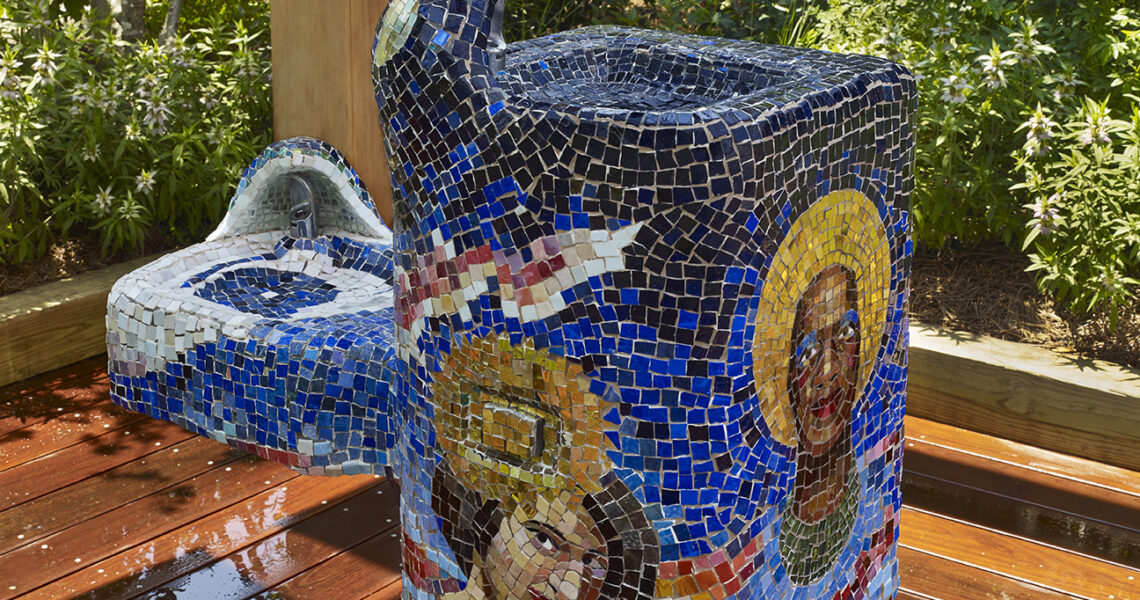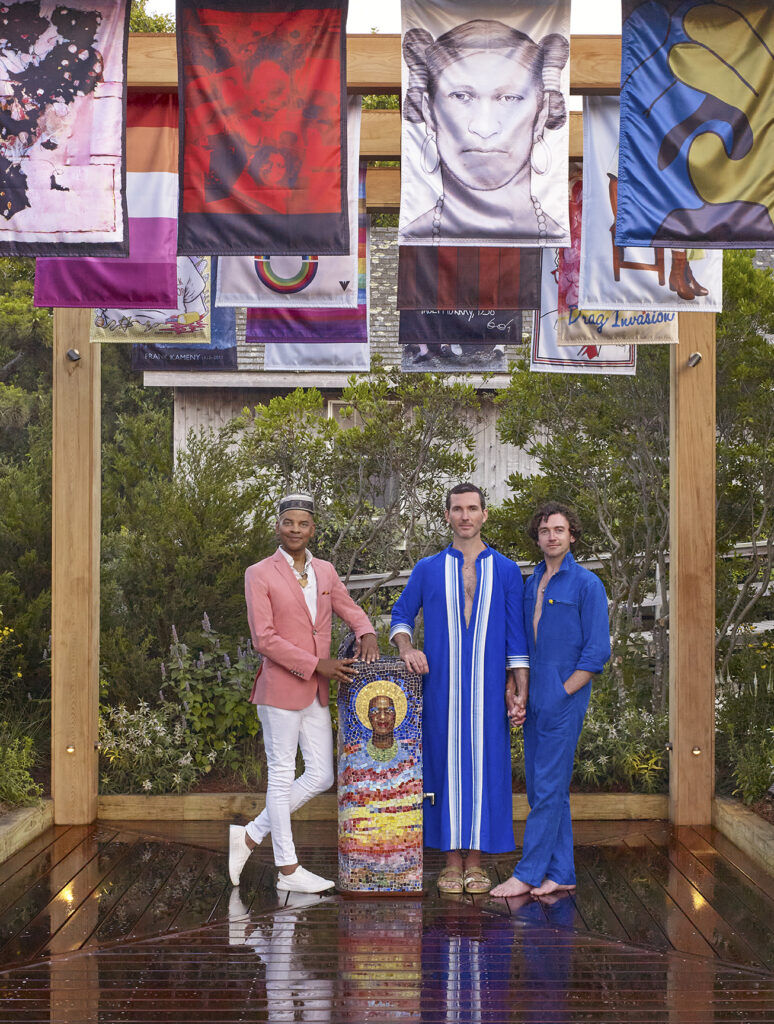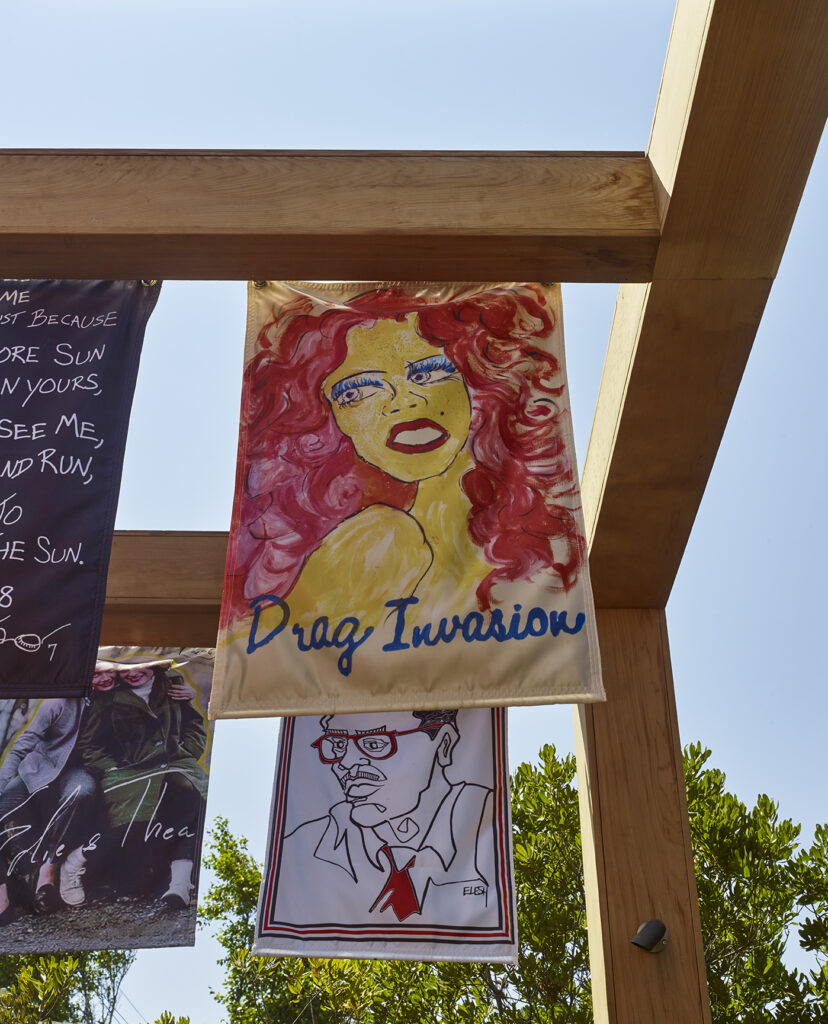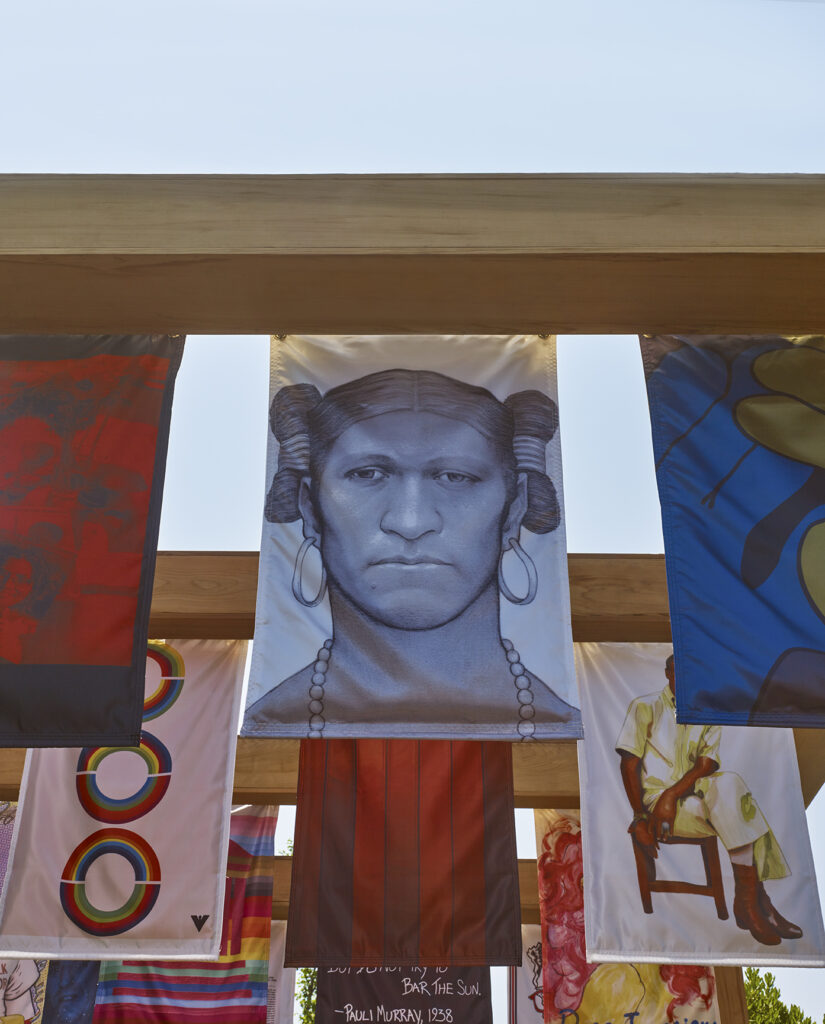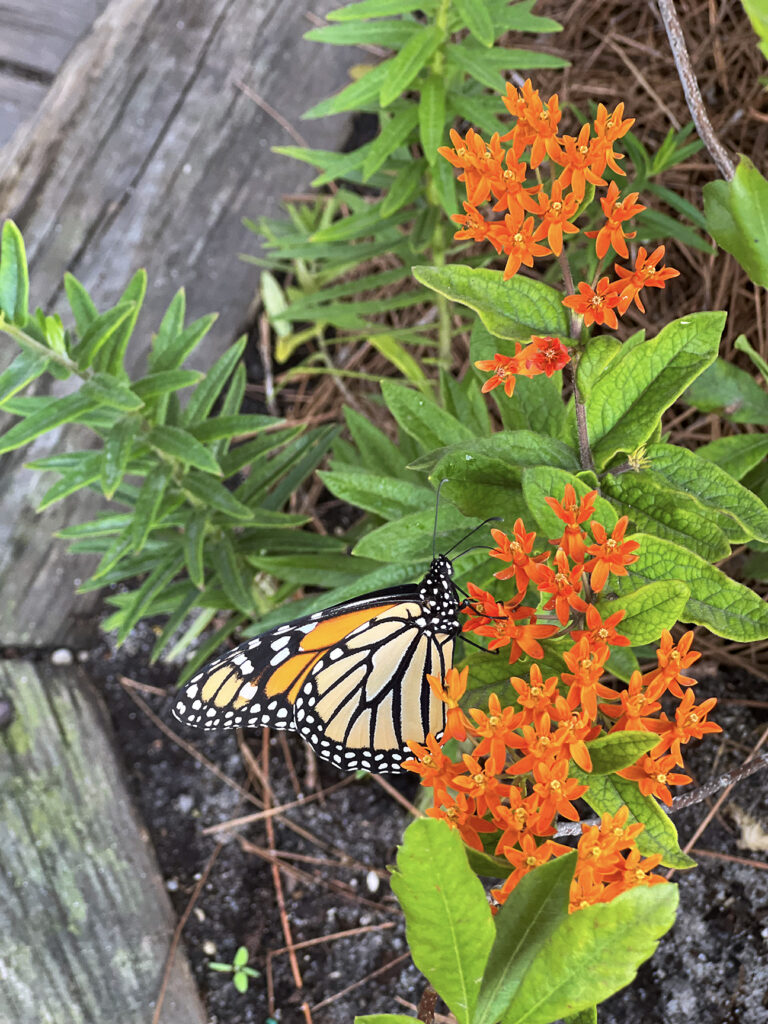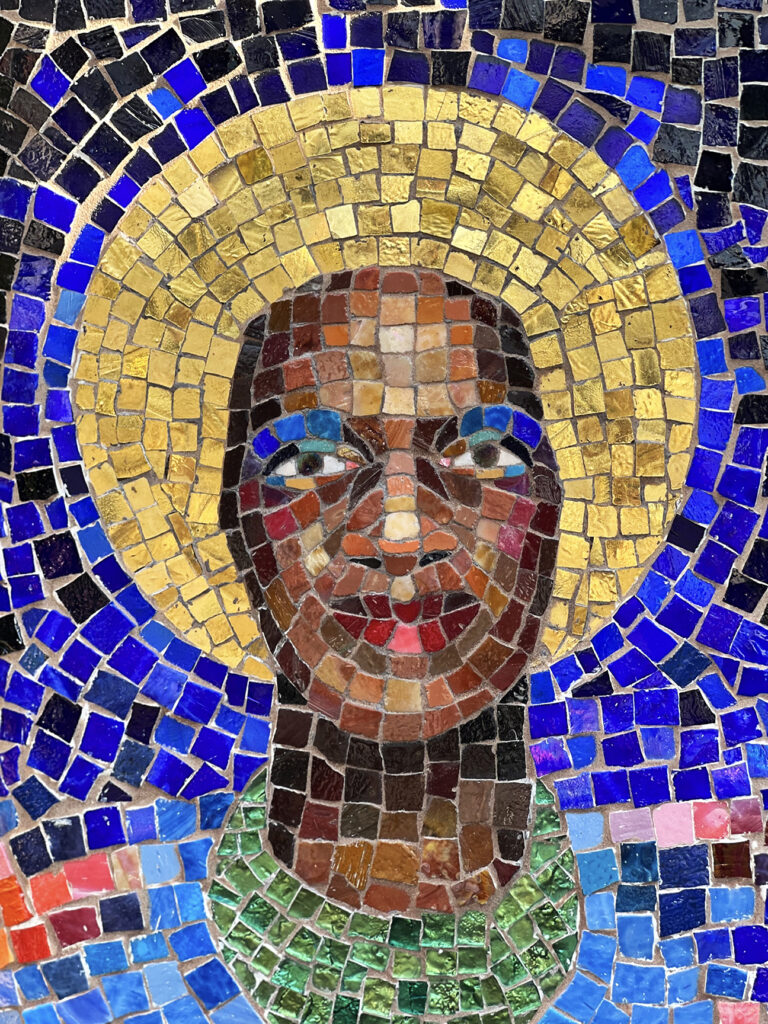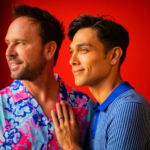From the ferry, it looks like a sculpture. However, walk a bit further along the plank-lined path and a greater functionality comes into view. The eye-catching, waist-high structure encrusted in colorful mosaic tiles is actually a public water fountain, the first of its kind in Fire Island Pines. STAR Fountain is the brainchild of artist TM Davy, and it also serves as the centerpiece of Trailblazers Park, a new permanent public space which opened in the Fire Island Pines Harbor this past July.
Depicted on STAR Fountain in vibrant shades of brown, gold and blue are Marsha P. Johnson and Sylvia Rivera, two trans activists and people of color who together launched the Street Transgender Action Revolutionaries in the 1970s, following the riots at Stonewall Inn in ‘69. Many point to Johnson, who was Black, as a key initiator of the uprising that took place on that fateful final Sunday in June, and thus her likeness is set in stone to commemorate her resilience.
“It gave me an opportunity to do more with my talents as an artist-activist, something that I’ve been playing with in directions that are maybe hard to quantify, or which haven’t quite made it into exhibition spaces,” Davy explains of his experience designing STAR Fountain, and working alongside the architect Scott Bromley on the larger park space, a professional known for projects like the Pines’ White Hall Community Center as well as the legendary Studio 54 nightclub. His husband, Liam O’Malley-Davy, is responsible for the intricate landscaping, which touts a wide array of flora and fauna that naturally exist on Fire Island.
“It’s a beautiful thing to watch young people of color get off the boat and go right up to the fountain with a sense of confidence,” says Crayton Robey, a filmmaker and member of the Pines’ Committee on Black Equality (CoBE), the committee behind the Park’s genesis. “They’re not intimidated, and then they leave this place with new possibilities and the ability to dream, because they see that there’s a piece of themselves represented here.”
Though Johnson and Rivera passed away in 1992 and 2002, respectively, their presence in the new art park extends a runway of visibility to those leading similar lives today. The Pines is a historically affluent community. Known for its wealthy residents and pristine beaches, it was intentionally inaccessible for years. As such, it lacked the more inviting touches available on other parts of the island where socio-economic statuses are of a wider range. A water fountain serves as a symbolic gesture that its reputation is changing, and that Fire Island Pines is becoming a more welcoming place for visitors from all levels of society.
That same inclusive spirit is also captured in the 16 satin flags that float above the singular public works project, each one designed by a different artist and celebrating a significant “trailblazer” from the LGBTQAI+ community.
“We’ve made a concerted effort to ensure there’s diversity in the group we’re honoring during any given time,” says Doug Harris, co-chair of CoBE and member of the Honoring Trailblazers Task Force. He goes on to share proudly that the committee collected more than 50 worthy nominees before deciding who would debut alongside the park. Of the 16 selected (or 18 including Johnson and Rivera), many are trans and black individuals whose stories remained on the fringes of obscurity until now. However, artwork honoring queer Asian Americans, a Native American, lesbians and others, are also prominently displayed, and will remain so through a second summer season. Then, every two years after, Davy and the team will commission artists to produce flags for the next round of honorees, all of whom will be selected from the existing nomination pool.
For now, guests have a chance to get acquainted with icons they’ve perhaps never heard about – names like We’wha, a famous Zuni Lhamana, or “two-spirit”, born in 1849 who challenged gender roles by taking on tasks that would otherwise be reserved for those identifying explicitly as male or female within their indigenous nation. Pauli Murray, the sole female graduate in Howard University’s School of Law, class of ‘44, and a significant legal scholar who dedicated her life’s work to securing civil rights for black and LGBTQ+ people, is another who may be new to some. Of course, familiar faces proved deserving of another moment in the spotlight with images of California politician, Harvey Milk (memorialized by queer graffiti artist Hugo Gyrl), and Glenn Burke, the first openly gay MLB player, being two sure stand outs.
“People are called into their own experience with the trailblazers,” Robey continues with a sense of wonder. “They’re drawn in by this fountain, which feels like a magical thing. And once they get inside the park, they see the flags and they become engaged by someone’s story. It gives them permission to be present, which is exactly what we wanted.”
The Park is another example of how tragedy can lead to transformation. Trailblazers Park was born out of conversations that took place after the killing of George Floyd and a 2020 summer defined by protests and activism.
“Fire Island Pines is a unique place, and it has a unique culture,” Harris shares. “Unfortunately, that culture hasn’t necessarily been very inclusive of people of color and following George Floyd’s murder a Committee on Black Equality (CoBE) was formed in the Pines, and it is part of the Fire Island Pines Property Owners Association (FIPPOA). Crayton and I are both members of that committee, and we made a number of recommendations as to how the Pines could become more diverse – at least be more inclusive and accessible to people of color, as well as trans and non-binary people.” One such recommendation was to create a public space dedicated to promoting inclusivity, and to honor individuals from communities whose contributions are often overlooked or underacknowledged. Soon, Allan Baum, VP of FIPPOA and The Pines Foundation, caught wind of the project and wanted to support their efforts with proceeds from the Pines Party — the largest fundraising event on the island, and one he oversees personally. Harris and Robey knew it was an opportunity to create something beautiful in collaboration with a collective of the Pines’ most creative residents. Trailblazers Park, which incorporates the work of local artists, architects, lighting designers, and other inventive minds, is the actualization of that dream.
“It’s wonderful that Trailblazers Park is not exclusive to any one group, that it’s broad and diverse,” Harris says. “But I do want people to remember that one of the primary reasons that this was established was to make the Pines a more inclusive and welcoming place. And TM really captured that by making the drinking fountain the center of Park because there’s nothing more welcoming, there’s nothing that says ‘we’re accessible’, more than a drinking fountain.”
A large number of this year’s trailblazers are deceased, but Harris says future installations will applaud living heroes, including residents of the Pines. There’s also the possibility that the Park will be expanded to include the neighborhood’s first ever public restrooms, which would be another thoughtful touch to make people feel more at home after their long journey by boat. But for now, Harris, Robey, Davy and the rest of the CoBE are enjoying the positive reception for the fountain as it stands, with hopes that the community will continue to rally around their mission with enthusiasm.
“It’s such a beautiful moment in history,” Robey says passionately. “It’s just so smart to take this idea of water and what it represents for our society and our world, and to broadcast a powerful message of inclusivity.”
[Photos by Peter Murdock]
Last modified: October 3, 2022

